Story by Becky Speere
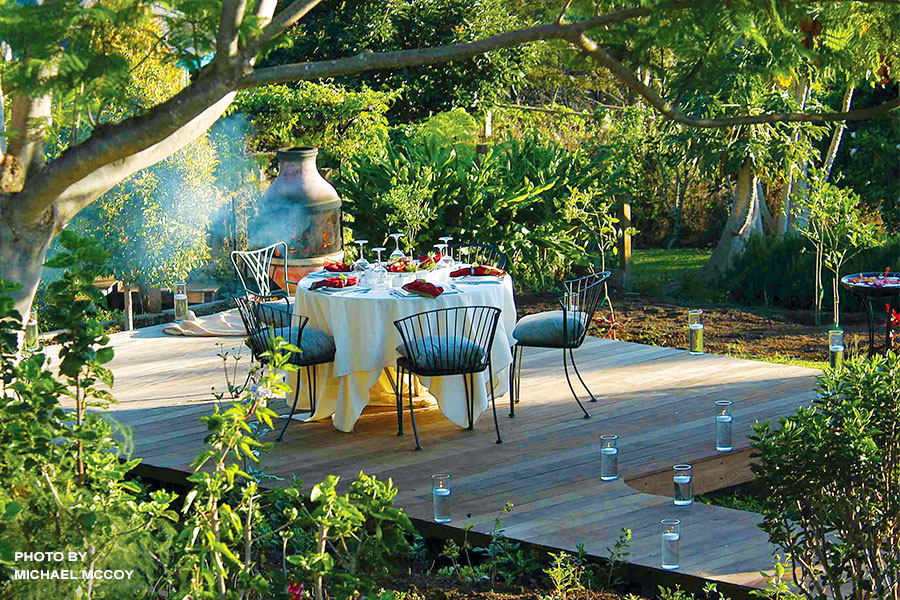
My edible landscape reflects my growing up on the “Big Island” of Hawai‘i, where we often sourced our food from bamboo fields or tropical forests, and the pristine ocean. Raised by a food-foraging mother, my four siblings and I looked at flora and fauna differently, learning to identify trees, vines, or ground cover as either edible or inedible. A drive to the countryside would invariably yield buckets of guavas, bamboo shoots, wild watercress and other delights.
So it is only natural that my kitchen door in rainy Huelo opens to a row of taro, a “canoe crop” brought to Hawai‘i by the first Polynesian settlers. Another canoe plant, a thirty-foot-tall mountain-apple tree laden with sweet, juicy fruit, occupies a corner of the yard next to a young jackfruit tree. In our courtyard sits katuk, a South American bush whose leaves are flush with chlorophyll and taste of string beans — at the ready for a midday nibble during yard work. Okinawan spinach, with its Kelly-green and magenta leaves, creeps along the fence, while my prized liliko‘i (passionfruit) vines hang in trees and on trellises, strung like yellow and green light bulbs in the warm midsummer breeze. Huge berms of banana trees provide fruit, and their leaves double as wraps for steaming food, all the while protecting the house against winds that gust through the valley.
I love having so much variety and flavor just beyond my doorstep, and take pride in knowing that, the more I live off the land, the more I’m contributing to Maui’s sustainability and lowering my carbon footprint.
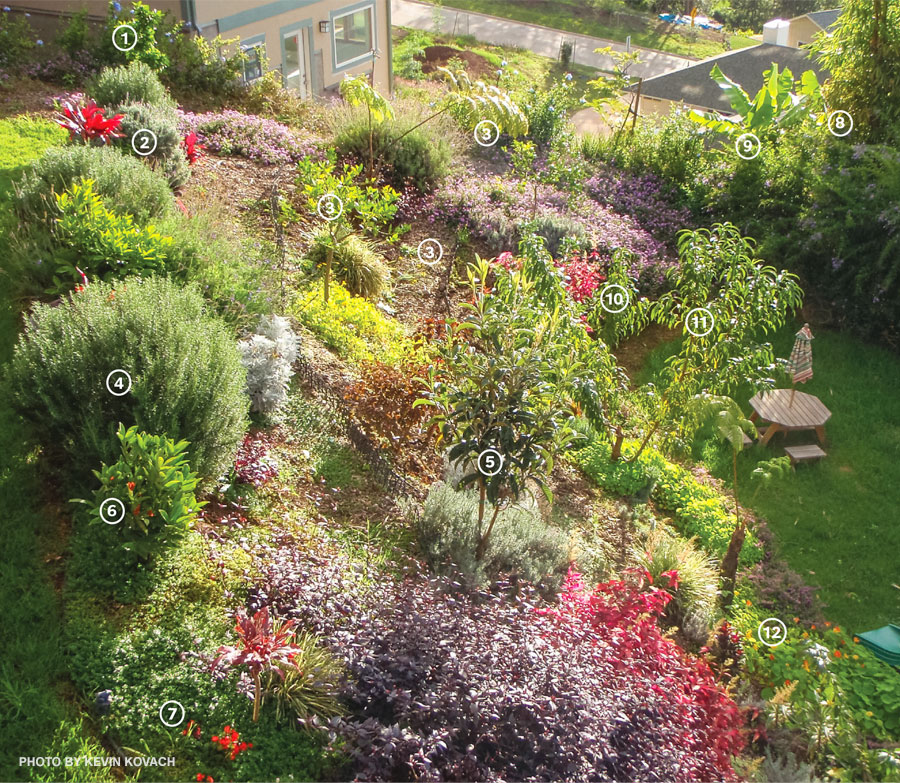
What to Plant
ALYSSUM, SWEET ALYSSUM, CARPET FLOWER
Lobularia maritima – This annual flowering plant is a member of the Brassicaceae family, native to the Mediterranean. A creeper, it’s a keeper for edgings, and comes in a multitude of colors.
WATER Light, gentle
SUN Full, or partial shade
ELEVATION Sea level to 2,500 feet
Use the tiny flowerheads as garnish; scatter individual flowers on a salad.
BILIMBI, KAMIAS, CUCUMBER TREE, TREE SORREL
Averrhoa bilimbi – Native to Southeast Asia, this cauliferous fruit-bearing tree grows to 20 feet, and is a close relative of carambola (starfruit).
WATER Moderate most of the year; heavy in summer
SUN Full
ELEVATION Tropical low elevations; does not grow at higher elevations
Fruit is ripe for picking when it begins to fall. May be candied and made into li hing mui-style local treats, added to curries, juiced, or eaten as is (although it will pucker your lips). Candy the flowers for desserts or garnish.
BORAGE, STARFLOWER
Borago officinalis – This hardy annual Mediterranean herb is used for companion planting — it helps ward off bugs and enriches the soil. In Maui’s drier regions, the plant will produce blooms and greens year-round.
WATER Moderate; allow soil to dry out between waterings.
SUN Full to partial
ELEVATION Sea level to 4,000 feet
The flowers (which taste like cucumber) and tender greens are edible raw, cooked, or candied (flowers only). Allow stalks to mulch into soil to provide nutrients for next season’s growth.
CHIVES
Allium schoenoprasum – A member of the onion family, chives will last three to four years and will need to be separated into more plants.
WATER Loves water
SUN Full
ELEVATION Sea level to 2,000 feet
Harvest by cutting leaves at the soil level. Although the leaves are the main part of the plant that’s used, the tufts of purple flowers are standouts in a salad.
GARDEN NASTURTIUM
Tropaeolum majus – Though it’s commonly called a nasturtium, this perennial plant doesn’t belong to the Nasturtium (watercress) genus. Native to Central and South America, it has acclimated to many locales and elevations.
WATER Low to moderate
SUN Full
ELEVATION Sea level to alpine
All parts of the plant are edible; Maui chefs use the flowers to garnish salads because of their peppery, watercress-like flavor. When young and tender, the seedpods can be pickled in a vinegar marinade and substituted for capers.
KALO, TARO
Colocasia esculenta – One of the original “canoe crops” brought here by the Polynesians, kalo grows in irrigated paddies or on dry land. All parts of the plant are edible and hypoallergenic.
WATER Heavy
SUN Full
ELEVATION Up to 2,000 feet
Depending on the variety, the corm may be harvested after eight to ten months. The lu‘au (leaf) may be picked throughout the growing season, but overharvesting reduces corm size. Calcium oxalate, a component of kidney stones, is present in raw and undercooked corms; steam or boil the corm until you can easily pierce it with a fork. Use in salads, stews, pound for poi, or saute with veggies and meat. Certain varieties can be sliced raw and fried as taro chips.
KATUK
Saurupus androgynous – This tropical perennial is a native of Borneo; the leaves and flowers have a taste reminiscent of sweet peas.
WATER Needs plenty of water, can tolerate brief flooding. Cannot tolerate dry.
SUN Prefers shade, but can tolerate full sun if given plenty of water.
ELEVATION Sea level to 2,000 feet
Katuk may be grown as a potted plant or an edible hedge. It propagates easily from cuttings; strip the leaves and stick the stem in the ground in the shade. In Malaysia, gardeners use lots of manure and water heavily to force the shoot tips to grow extra long and tender. Called tropical asparagus in its tender stage, the leaves may be stir-fried or tossed raw into salads.
KO‘OKO‘OLAU
Bidens menziesii – A member of the Asteraceae family, this perennial relative of the sunflower is an endemic herb that grows in widely varying conditions.
WATER Light
SUN Full
ELEVATION Sea level to 8,000 feet
Dry the leaves to make a healthful tea. Plant new crops regularly for a continual supply of leaves.
LOULU
Pritchardia glabrata – This is Hawai‘i’s only native palm, but it has about 24 varieties. Grows from 15 to 30 feet tall, with a canopy 10 to 12 feet wide, and a life span of more than 5 years.
WATER Moderate
SUN Full
ELEVATION Grows at lower elevations but mainly in the wild at 1,000 feet
Ancient Hawaiians ate the loulu seed in times of famine. Today the seed is considered a delicacy, enjoyed raw.
MAMAKI
Pipturis albidus – Perennial and indigenous to Hawai‘i, this member of the nettle family can grow as a shrub or small tree. Propagate from cuttings or seeds.
WATER Ample, with well-drained soil
SUN Prefers partial sun; if in full sun, water frequently.
ELEVATION Sea level to 4,000 feet
Once dried, the mature leaves can be brewed for a noncaffeinated tea; simmer in water till tea is dark, about 4 minutes. Never harvest more than a quarter of the leavesof the entire plant.
OLIVE
Olea europaea – This shrub or small tree is native to Africa, the Mediterranean and Asia. A few specific cultivars grow well in Maui’s subtropical climate.
WATER Moderate until seedlings set roots; then minimal
SUN Full
ELEVATION Sea level to 4,000 feet
Young leaves dry quickly and can be brewed for tea. Serve the tea iced or hot, mixed with honey and lemon. Cure the olives in lime or brine them in salt before eating; they can also be pressed into oil.
PINEAPPLE
Ananas comosus – Indigenous to South America, this herbaceous perennial is part of the Bromeliad family. European explorers named the fruit for its resemblance to pine cones.
WATER Light
SUN Full
ELEVATION Sea level to 2,000 feet
The fruit is sweetest and ready to harvest when the skin is entirely yellow. Peel the skin and remove the core if it’s tough and fibrous. Use fresh, toss in a green-papaya salad, or add to smoothies; chargrill for kabobs or pizza topping. Plant the crown, and you can produce a second, smaller generation.
SWEET OLIVE, TEA OLIVE
Osmanthus fragrans – This tree grows throughout Asia, where it’s cultivated as an ornamental with wonderfully fragrant flowers.
WATER Ample, in well-drained soil
SUN Partial; will tolerate full sun with increased watering
ELEVATION Sea level to 3,000 feet
Harvest the flowers in summer and autumn and add them to simple syrup, or dry them for what is called Dragon Bead tea in China.
SWEET WILLIAM
Dianthus barbatus – This herbaceous biennial is a popular ornamental; it flowers in the second year. Native to Europe, it can be grown in pots or planted directly in gardens.
WATER Moderate
SUN Full
ELEVATION Sea level to 4,000 feet; does not like frost
The assorted colors make attractive salad garnishes for sweet and savory platings. Petals are generally stripped off the flowerhead for use.
TAHITIAN LILIKO‘I, JAMAICAN HONEYSUCKLE, ORANGE LILIKO‘I, WATER LEMON
Passiflora laurifolia – Native to the American tropics, this perennial vine grows to 30 feet, with dramatic flowers that yield to medium-sized, ovoid fruit.
WATER Moderate
SUN Full
ELEVATION Sea level to 1,000 feet
Fruit is ready to eat off the vine when it turns papaya yellow. The seed mass within the soft rind is sweet and floral tasting, unlike the intensely tart common yellow liliko‘i.
RESOURCE GUIDE
Ace Hardware
334 Alamaha Street, Kahului | 877-3931
1279 S. Kihei Road, Kihei | 879-7060
840 Waine‘e Street, Lahaina | 667-5883
Anahata Farms
Upcountry Farmers Market (Sat. 7 a.m.-noon)
55 Kiopa‘a Street, Pukalani
Info@UpcountryFarmersMarket.com
EcoScapes Maui
Kevin Kovach | 214-3047
EcoScapesMaui.com
Home Depot
100 Pakaula Street, Kahului | 893-7800
Ho‘olawa Farms
3 Kahiapo Place, Ha‘iku
575-5099 | Hoolawa@hawaii.rr.com
Mon.-Fri. 8 a.m.-4 p.m., Sat.-Sun by appt.
Kula True Value Hardware & Nursery
3100 Lower Kula Road, Kula | 876-0734
Lowe’s Home Improvement
270 Dairy Road, Kahului | 873-0383

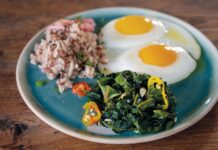
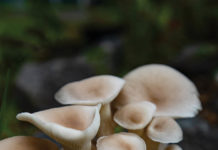
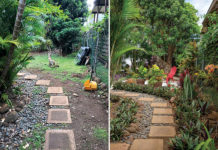
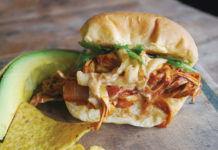

wonderful article! thanks